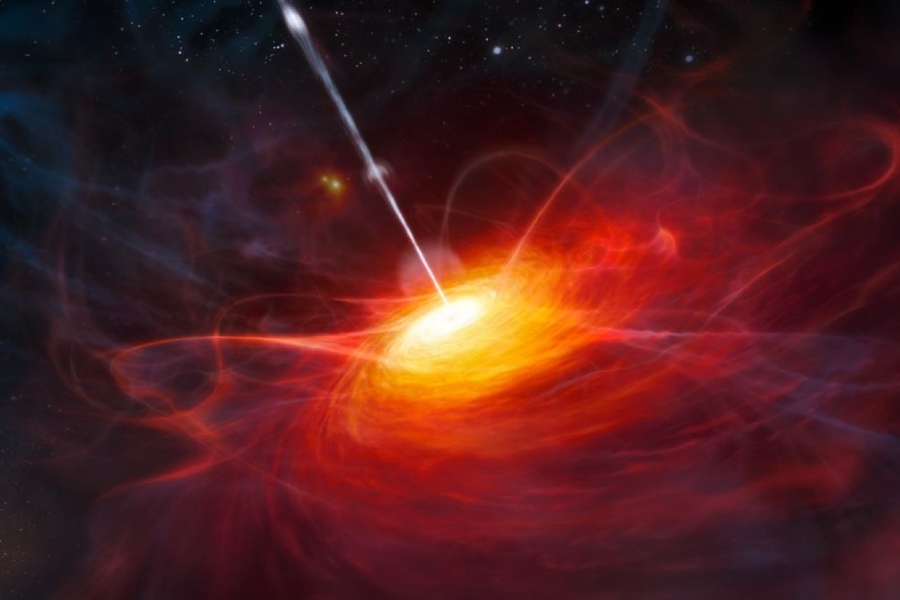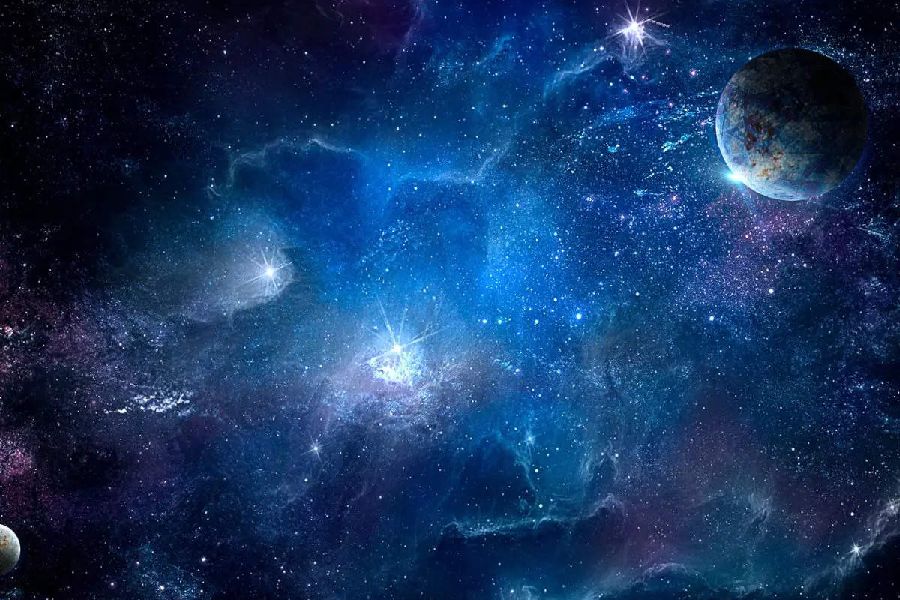At the heart of most large galaxies resides a dark, wondrous entity with a mass beyond comprehension. Ranging from millions to billions of solar masses, these invisible giants ensnare everything that draws near.
But why do these giants bear the name supermassive black holes? What are supermassive black holes precisely, and what powers their vast gravitational grip on galactic centers? Where do these cosmological leviathans come from, and what secrets do they hold within? This article will probe as close to the boundaries of the most mammoth black holes discovered, chasing clues about their elusive origins and behaviors.
We’ll find clues about supermassive black holes in the violent jets of energy and light blasting from them. These hints reveal how these infant black holes balloon to enormous sizes so quickly. We’ll uncover whispers about their origins, composition, appetite, and their crucial role at the heart of galaxies.
Diving into Einstein’s warped space-time predictions made manifest, we’ll piece together the puzzle of these dark matter-eating engines of the universe. The investigation ahead promises discoveries about supermassive black holes, challenging your conceptions with what still remains unseen. Do we have your attention now? Good, let’s begin!

What Are Supermassive Black Holes?
Supermassive black holes are extremely large and incredibly dense regions in space where gravity is so strong that nothing, not even light, can escape from them.
These black holes can be millions or even billions of times more massive than our Sun, and they exist at the centers of most galaxies, including our own Milky Way. Scientists believe that supermassive black holes play a crucial role in the formation and evolution of galaxies.
Mass & Size
How big are supermassive black holes? Supermassive black holes contain unfathomably large masses equal to millions to billions of Suns crammed together. Their masses create intensely powerful gravitational fields able to rule over entire galaxies.
A supermassive’s event horizon marks the point of no return where nothing escapes if it once crosses. Supermassive horizons are smaller than our solar system but tremendously dense, packing millions of solar masses into areas the width of our Moon.
Though supermassive black holes are compact compared to the scale of galaxies, they exert major control over galactic formation and evolution due to their extreme gravitational forces. Over billions of years, supermassives have grown alongside galaxies – evidence today shows their mutual, intertwined development.
Gravitational Pull & Waves
Supermassive black holes generate immensely powerful gravity fields. These powerful fields can accelerate surrounding matter to over 1 million mph. They can also rip stars apart as supermassives feed on clouds of gas.
The extreme warping of spacetime outside a supermassive uniquely bends light and accelerates matter into jets of radiation. This dramatic distortion is unique to the gravity of these giant black holes.
If two supermassives collide when galaxies merge, they could unleash intense spacetime ripples called gravitational waves – detectable across the universe. Only collisions of the most massive objects can release waves that strong.
Location of Supermassive Black Holes
Supermassive black holes overwhelmingly reside at the centers of galaxies, including the Milky Way’s giant called Sagittarius A, with their central location being tied to galaxies forming around clumps of dark matter early on.
A supermassive’s powerful gravity dominates motions in its host galaxy for hundreds of thousands of lightyears. Over time, it molds spiral arms and generates jets that stretch beyond the galaxy itself.
Some merging galaxies temporarily host dual supermassives orbiting each other before combining. However, only one supermassive anchor is detected at the cores of mature galaxies, which are observed presently.

Active Galaxies & Host Galaxies
Quasars – extremely bright galactic cores – are likely fueled by closely orbiting supermassive black holes. Gas accelerating around the black hole releases tremendous energy detected as a bright quasar.
When abundant matter falls toward the central supermassive, it forms a glowing disk that feeds the black hole. Whirling rapidly, the disk reaches intense temperatures and shines powerfully, as seen in quasars.
The state of the host galaxy and its central supermassive evolve together over eons, including through the luminous quasar phase. Larger central black holes inhabit bigger galaxies with more stellar mass, suggesting key stages are still being uncovered.
Elliptical & Dwarf Galaxies
Giant elliptical galaxies contain proportionally massive yet quiet supermassives in their spherical cores. Many ellipticals formed from past mergers that combined two central black holes into one more massive beast.
Elliptical cores glow dimly since less gas falls inward to ignite the appetite in their sleeping giants. Without stirred-up fuel, old ellipticals maintain a peaceful existence around central supermassives.
The question of whether tiny dwarf galaxies always harbor central supermassives still remains a mystery. If there’s a change of tiny dwarf galaxies harboring central supermassives, the black holes start as miniature ones and gradually expand with time. What’s surprisingly interesting is that finding intermediate-mass black holes in dwarfs would support theories about supermassive origins and early growth.
Nearby Galaxy & Milky Way
The nearby Andromeda Galaxy hosts a central supermassive over 100 million solar masses. At only 2.5 million lightyears away, observations help uncover secrets of our own galaxy’s heart. Astronomers verified a 4-million-solar-mass supermassive named Sagittarius A* hides at the center of the Milky Way 25,000 lightyears from Earth, impacting the patterns of stars under its gravitational command. Sagittarius A* stays remarkably dim, showing little fiery accretion activity. But flares help betray its location at the heart of the Milky Way, where our galaxy’s gravitational kingpin lurks quietly most of the time.
Discovery of Supermassive Black Holes
The concept of supermassive black holes developed in the early 20th century, with a connection proposed to newly discovered bright quasars in the 1960s. It revealed signatures of matter swirling rapidly around them.
This matter eventually falls inward due to the immense gravitational pull of the black hole. The Hubble Space Telescope tracked stars orbiting very fast around invisible central objects in nearby galaxies like our Milky Way. Only tremendously heavy supermassives could yank stars around so quickly, betraying their location.
Chandra X-Ray Observatory & Hubble Space Telescope
The Chandra X-Ray Observatory maps out X-ray emissions from hot gas swirling rapidly into supermassives, revealing accretion and growth details. Chandra also detected intense X-ray jets, fueled by the central supermassive’s tremendous gravity and magnetism, extending far beyond the galaxy.
The Hubble Space Telescope pinpointed stars orbiting very fast around the Milky Way’s central supermassive called Sagittarius A. Only an extremely compact, massive object could whip stars around so quickly.
Conclusion
This article explored several supermassive black holes facts that deepen our understanding of these mysterious phenomena. These objects occupy the centers of galaxies, and their immense gravity impacts the structures surrounding them over eons.
We explored their extreme masses concentrated into tiny regions of space-time, generating observational effects from feeding processes.
New instruments probing galactic cores aid ongoing work in uncovering more about supermassive black holes’ formation and connections to ancient quasars. By investigating their powerful properties up close, we hope you better comprehend the central role these gravitational behemoths play.
They are intimately partnered with galaxies spanning billions of light-years. Together, they birth luminosity across the cosmos. Where galaxies glow bright, dark giants surely lurk at the heart – the “supermassive black holes” enabling stars to shine in the first place.
